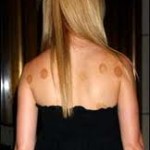What are Those Red Circles on US Olympic Athletes?

What are those pepperoni-like bruises on the shoulders of Olympic superstar Michael Phelps?
Seems like a number of athletes, including US gymnast Alex Naddour and Belarus swimmer Pavel Sankovich are sporting the tell tale marks of cupping.
It was in 2010, we cited cupping as a celebrity health fad of the year, when celebrities such as Gwyneth Paltrow and Paris Hilton, Victoria Beckham and Jessica Simpson were seen .
 Swimmer Sankovich posted this image to his Instagram account this summer: “Cupping is a great recovery tool.” Those are the suction cups all over his thighs!
Swimmer Sankovich posted this image to his Instagram account this summer: “Cupping is a great recovery tool.” Those are the suction cups all over his thighs!
So, what is cupping, and is there any scientific proof for the claims its proponents make?
Cupping
Cupping is one of the oldest methods of traditional Chinese medicine, going back at least 2000 years. In cupping, local suction is created on the skin; practitioners believe this mobilizes blood flow and removes toxins which promotes healing.
Broadly speaking there are two types of cupping: dry cupping and bleeding or wet cupping.
 In both methods, an area of low pressure is created next to the skin by the cup. This draws the skin into the cup, lifting the muscle fascia and pulling it away from the underlying sub-fascia. It also increases blood flow to the underlying area.
In both methods, an area of low pressure is created next to the skin by the cup. This draws the skin into the cup, lifting the muscle fascia and pulling it away from the underlying sub-fascia. It also increases blood flow to the underlying area.
The cups can be various shapes including balls or bells. Plastic and glass are the most common materials used today, replacing the horn, pottery, bronze and bamboo cups used in earlier times.
In dry cupping, the low air pressure can be created by heating the cup or the air inside it with an open flame (called fire cupping) or a bath in hot scented oils, then placing it against the skin. As the air inside the cup cools, it contracts and draws the skin slightly inside. Alternately, a vacuum can be created with a mechanical suction pump acting through a valve located at the top of the cup. The cups can be left in place, or moved around th e affected area.
e affected area.
In wet cupping, a small scratch or incision is made with a lancet before the cup is applied. The pressure difference extracts blood from the skin.
Patients report that cupping feels a bit like a deep tissue massage. Skin marking is common after the cups are removed. This may be a simple red ring that disappears quickly, or swelling and bruising may persist for a few days.
Does it work?
Unlike many other health fads, cupping has been subjected to a considerable amount of scientific investigation. Studies have looked at it’s use in a wide variety of ailments, including low back pain, herpes zoster (shingles), cancer pain, and migraine headaches.
 Although many studies have been done, many are considered to be of “low methodological quality” by scientists who have reviewed them, leaving their results suspect. However, the same reviewers state that “cupping has potential effect in the treatment of herpes zoster and other specific conditions” but that more rigorously designed trials are necessary.
Although many studies have been done, many are considered to be of “low methodological quality” by scientists who have reviewed them, leaving their results suspect. However, the same reviewers state that “cupping has potential effect in the treatment of herpes zoster and other specific conditions” but that more rigorously designed trials are necessary.
Updated reviews in the past couple of years (Cao and Liu, Chen et.al) still find that many studies are done using suboptimal scientific methods. Cao and Liu, however do conclude that their analysis “showed cupping therapy combined with other TCM (traditional chinese medicine) treatments was significantly superior to other treatments alone in increasing the number of cured patients with herpes zoster [shingles], facial paralysis [Bell’s Palsy], acne, and cervical spondylosis.
Fortunately, the studies have also revealed that cupping has no serious side effects (although some skin burns have been described.)
As Professor Edzard Ernst, an international authority on complementary medicine at the University of Exeter, says:
There is no evidence for its efficacy. It has not been submitted to clinical trials, but there have certainly been satisfied customers for 3,000 years.



























1 Comment